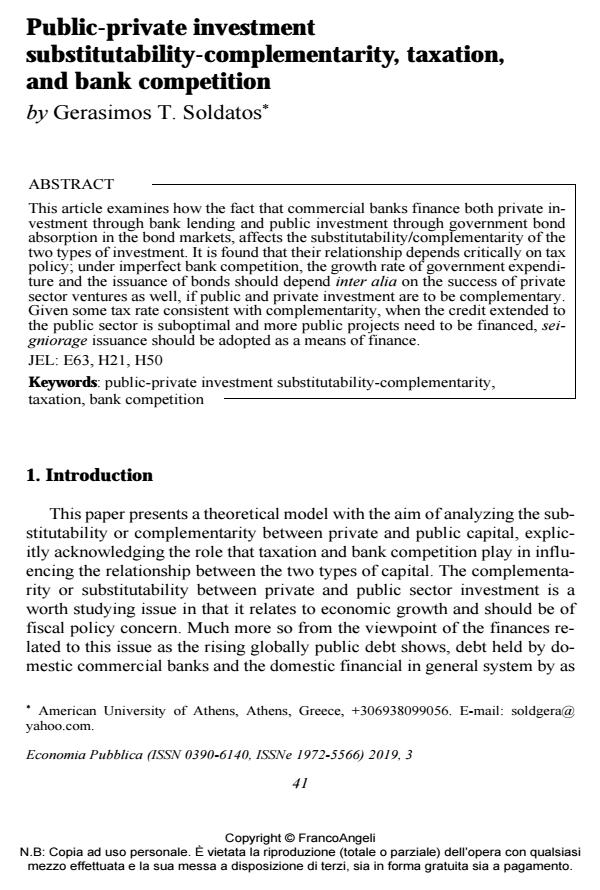Public-private investment substitutability-complementarity, taxation, and bank competition
Titolo Rivista ECONOMIA PUBBLICA
Autori/Curatori Gerasimos T. Soldatos
Anno di pubblicazione 2020 Fascicolo 2019/3 Lingua Inglese
Numero pagine 21 P. 41-61 Dimensione file 525 KB
DOI 10.3280/EP2019-003002
Il DOI è il codice a barre della proprietà intellettuale: per saperne di più
clicca qui
Qui sotto puoi vedere in anteprima la prima pagina di questo articolo.
Se questo articolo ti interessa, lo puoi acquistare (e scaricare in formato pdf) seguendo le facili indicazioni per acquistare il download credit. Acquista Download Credits per scaricare questo Articolo in formato PDF

FrancoAngeli è membro della Publishers International Linking Association, Inc (PILA)associazione indipendente e non profit per facilitare (attraverso i servizi tecnologici implementati da CrossRef.org) l’accesso degli studiosi ai contenuti digitali nelle pubblicazioni professionali e scientifiche
This article examines how the fact that commercial banks finance both private investment through bank lending and public investment through government bond absorption in the bond markets, affects the substitutability/complementarity of the two types of investment. It is found that their relationship depends critically on tax policy; under imperfect bank competition, the growth rate of government expenditure and the issuance of bonds should depend inter alia on the success of private sector ventures as well, if public and private investment are to be complementary. Given some tax rate consistent with complementarity, when the credit extended to the public sector is suboptimal and more public projects need to be financed, seigniorage issuance should be adopted as a means of finance.
Keywords:Public-private investment substitutability-complementarity, taxation, bank competition
Jel codes:E63, H21, H50
- Acemoglu D. and Johnson S. (2005). Unbundling institutions. Journal of Political Economy, 113: 949-995. DOI: 10.1086/432166
- Aschauer D.A. (2000). Public capital and economic growth: Issues of quantity, finance, and efficiency. Economic Development and Cultural Change, 48(2): 391-406. DOI: 10.1086/452464
- Atif A., Flyvbjerg B., Budzier A. and Lunn D. (2016). Does infrastructure investment lead to economic growth or economic fragility? Evidence from China. Oxford Review of Economic Policy, 32(3): 360-390.
- Bahal G., Raissi M. and Tulin V. (2018). Crowding-Out or Crowding-In? Public and Private Investment in India. National Council of Applied Economic Research Working Paper N. 114. Berger A.N. and Hannan T.H. (1998). The efficiency cost of market power in the banking industry: A test of the ‘quiet life’ and related hypotheses. Review of Economics and Statistics, 80(3): 454-465. DOI: 10.1162/003465398557555
- Berger A.N., Demirgüç-Kunt A., Levine R. and Haubrich J.G. (2004). Bank concentration and competition: An evolution in the making. Journal of Money, Credit, and Banking, 36(3): 433-451.
- Bom P.R.D. (2017). Factor-biased public capital and private capital crowding out. Journal of Macroeconomics, 52: 100-117.
- Bucci A. and Del Bo C. (2012). On the interaction between public and private capital in economic growth. Journal of Economics, 106(2): 133-152.
- Canning D. and Pedroni P. (1999). Infrastructure and long run economic growth. Harvard Institute for International Development, Consulting Assistance on Economic Reform Discussion Paper N. 57. -- http://citeseerx.ist.psu.edu/viewdoc/download?doi=10.1.1.489.6497&rep=rep1&type=pdf.
- Carlson K.M. and Spencer R.W. (1975). Crowding out and its critics. Federal Reserve Bank of St. Louis Review, Issue Dec, 2-17. -- https://files.stlouisfed.org/files/htdocs/publications/review/75/12/Crowding_Dec1975.pdf.
- Dehn J. (2000). Private investment in developing countries: The effects of commodity shocks and uncertainty. Oxford University Centre for the Study of African Economies Working Paper N. 11. -- https://www.csae.ox.ac.uk/materials/papers/20-11text.pdf.
- Dregera C. and Reimers H.-E. (2016). Does public investment stimulate private investment? Evidence for the euro area. Economic Modelling, 58: 154-158.
- Eisfeldt A.L. and Muir T. (2016). Aggregate external financing and savings waves. Journal of Monetary Economics, 84(C): 116-133.
- Ferreira F.H.G. (1995). Roads to equality: Wealth distribution dynamics with publicprivate capital complementarity. LSE STICERD Research Paper N. TE/1995/286. -- http://sticerd.lse.ac.uk/dps/te/te286.pdf.
- Gasteuil-Rougier A. (2013). Developed countries: Who holds the Debt?. Société Générale ECONOTE 16. -- https://www.societegenerale.com/sites/default/files/documents/Econote/130429%20Econote16_Dette_EN.pdf.
- Gordon R.J. (2015). Secular stagnation: A supply-side view. American Economic Review, 105(5): 54-59.
- Houston J. and James C. (1996). Bank information monopolies and the mix of private and public debt claims. Journal of Finance, 51(5): 1863-1889.
- Khan M.S. and Kumar M.S. (1997). Public and private investment and the growth process in developing countries. Oxford Bulletin of Economics and Statistics, 59(1): 69-88. DOI: 10.1111/1468-0084.00050
- King J.E. (2015). Advanced Introduction to Post Keynesian Economics. Cheltenham, UK and Northampton, MA: Edward Elgar. Mendez-Quesada E. and Munoz-Salas E. (1998). Determinants of private fixed investment in Costa Rica. Banco Central de Costa Rica Working Paper DIE-PI-06-96.
- Misch F., Gemmell N. and Kneller R. (2013). Growth and welfare maximization in models of public finance and endogenous growth. Journal of Public Economic Theory, 15(6): 939-967.
- Morozumi A. (2016). Institutions and public investment as a fiscal stimulus. University of Nottingham. -- https://editorialexpress.com/cgi-bin/conference/download.cgi?db_name=MMF2016&paper_id=226.
- Rognlie M. (2014). A note on Piketty and diminishing returns to capital. -- http://mattrognlie.com/piketty_diminishing_returns.pdf.
- Romp W.E. and de Haan J. (2007). Public capital and economic growth: A critical survey. Perspektiven der Wirtschaftspolitik, 8(S1): 6-52.
- Saunders A., Strock E. and Travlos N.G. (1990). Ownership structure, deregulation, and bank risk taking. Journal of Finance, 45(2): 643-654.
- Stournaras C.F. (2016). Endogenous fiscal growth and public macroeconomics: In search for optimality under externality. University of Birmingham.
Gerasimos T. Soldatos, Public-private investment substitutability-complementarity, taxation, and bank competition in "ECONOMIA PUBBLICA " 3/2019, pp 41-61, DOI: 10.3280/EP2019-003002